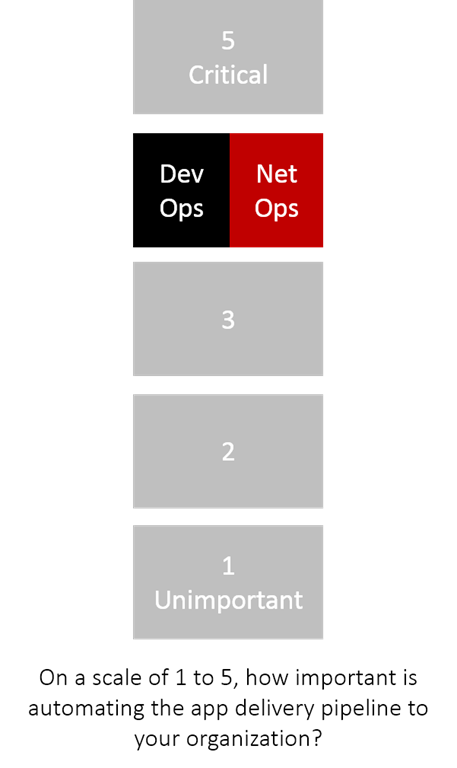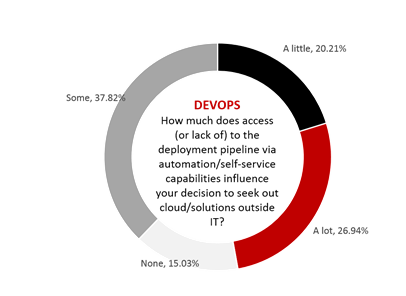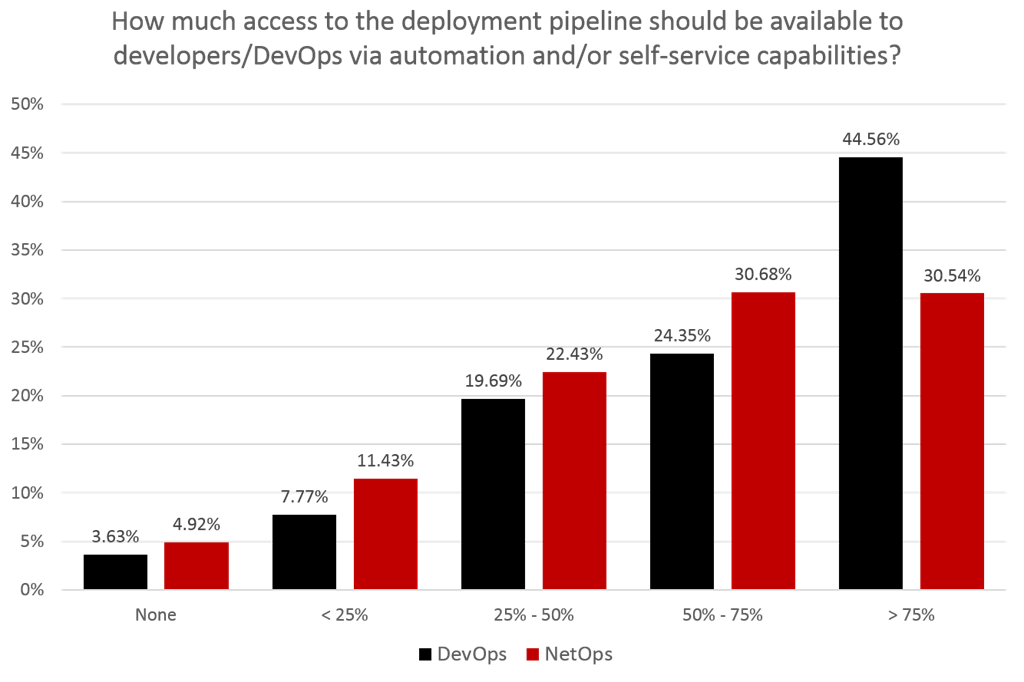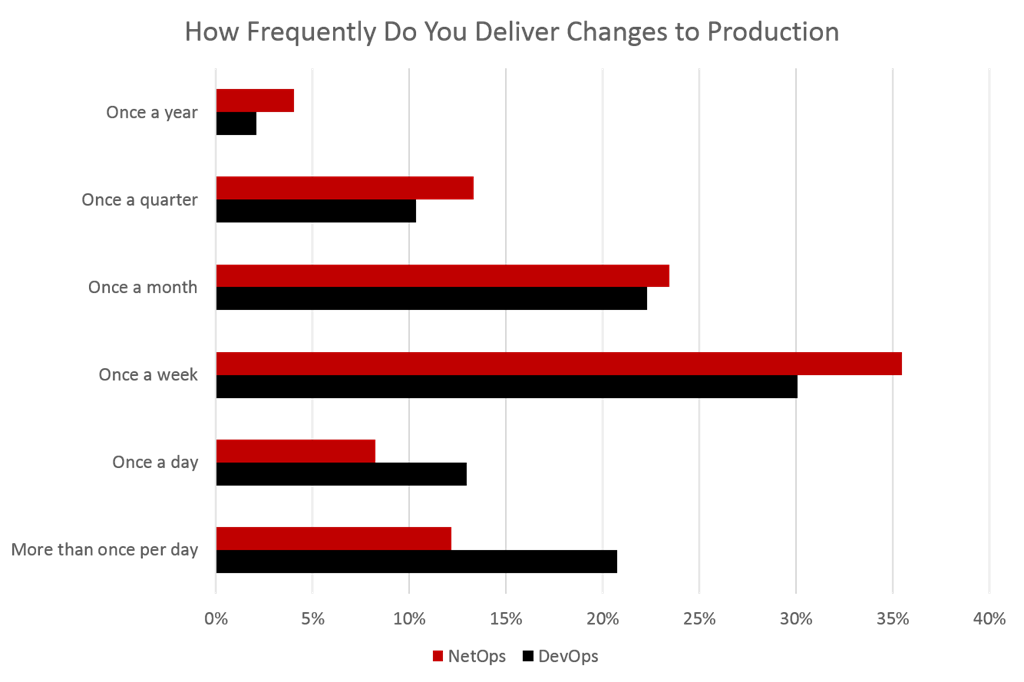Relatório da pesquisa F5 DevOps e NetOps: A automação é a chave para reduzir a exclusão digital
Muito se fala sobre o relacionamento arquetípico entre DevOps e NetOps. Somos constantemente bombardeados com uma ladainha de retórica "nós contra eles" que coloca um contra o outro, lançando solicitações e acusações de um lado para o outro sobre o muro que os separa. Com o aumento da pressão para entregar aplicativos com mais rapidez e frequência, esse muro pode se tornar a divisão digital que separa os vencedores na economia de aplicativos de todos os outros.

Felizmente, essa exclusão digital está diminuindo graças à automação e orquestração de TI. Descobrimos o desejo de colaborar para fechar esse abismo digital tanto por parte de NetOps quanto de DevOps quando pesquisamos separadamente cada grupo, investigando seu uso da tecnologia, percepções uns dos outros e os aplicativos que eles entregam. Essa é uma notícia cada vez melhor para empresas que estão embarcando em esforços de transformação digital que exigem a escala e a velocidade que somente a automação e a orquestração podem efetivamente alcançar. Também são boas notícias para organizações que enfrentam dificuldades com ambientes multi-nuvem que exigem maior atenção de funcionários já sobrecarregados. Aliviar a pressão no local com automação pode liberar recursos para atender a projetos relacionados à nuvem.
884 profissionais de NetOps e DevOps responderam a pesquisas on-line realizadas no verão de 2017. Fizemos diversas perguntas relacionadas à percepção sobre aplicativos em geral e suas contrapartes em NetOps ou DevOps, bem como perguntas focadas na percepção de frequência e taxas de sucesso de implantações.
Os resultados mostram que, embora o muro entre eles ainda exista, ele não é tão alto ou opaco quanto o diálogo dentro das comunidades ou outros relatórios do setor afirmam. Encontramos muitos pontos em comum entre organizações de todos os tamanhos e setores com relação à importância e ao desejo de automação do pipeline de produção, bem como confiança mútua na segurança, no desempenho e na confiabilidade dos aplicativos que ambos os grupos se esforçam para desenvolver e implantar.
A automação parece ser uma força unificadora para NetOps e DevOps. Em princípio, pelo menos, se não nos detalhes específicos de implementação.
 Embora DevOps e NetOps continuem em desacordo sobre quanto acesso ao pipeline deve estar disponível via autoatendimento e automação, na maioria dos casos, ambos os grupos veem o outro no caminho certo. 82% dos DevOps e 76% dos NetOps concordam que cada um prioriza “as coisas certas”. Claramente, há um ponto em comum em toda a exclusão digital, pelo menos em objetivos e foco, embora nem sempre no organograma.
Embora DevOps e NetOps continuem em desacordo sobre quanto acesso ao pipeline deve estar disponível via autoatendimento e automação, na maioria dos casos, ambos os grupos veem o outro no caminho certo. 82% dos DevOps e 76% dos NetOps concordam que cada um prioriza “as coisas certas”. Claramente, há um ponto em comum em toda a exclusão digital, pelo menos em objetivos e foco, embora nem sempre no organograma.
Entre os dissidentes do lado do NetOps, a resposta mais comum sobre o que o DevOps não prioriza o suficiente incluía a segurança. A confiabilidade também surgiu frequentemente como uma fonte de frustração com o DevOps por parte de seus equivalentes NetOps.
Confiabilidade e segurança são tão importantes quanto a velocidade de entrega. A segurança ainda é uma reflexão tardia. Desempenho, segurança, confiabilidade.
Não é de surpreender que um dos argumentos mais comuns do DevOps em relação à priorização pelo NetOps tenha sido centrado na automação. Ou melhor, a falta dela.
automação automação automação. Gostaria de vê-los priorizar a criação de recursos automatizada e independente de nuvem no espaço da nuvem. Automação, devops, nuvem, segurança.
Essa diferença de opinião provavelmente está na raiz da nossa próxima descoberta importante, que expôs o efeito que a falta de acesso ao pipeline de produção por parte dos desenvolvedores e do DevOps por meio de automação e autoatendimento tem na adoção da nuvem e de soluções fora da TI.
Automação impacta adoção da nuvem
Eles podem ouvir você agora. Há muito tempo acredita-se que um dos motivadores da adoção da nuvem — tanto por partes interessadas de negócios quanto de DevOps — é a falta de acesso de autoatendimento ao pipeline de implantação de produção, o que resulta em longos ciclos de implantação. A notícia não tão boa é que nossa pesquisa valida essa crença, com 27% dos DevOps indicando que isso influencia sua decisão de buscar soluções baseadas em nuvem “muito” e 38% influencia “algum”. A boa notícia é que a NetOps não está alheia ao impacto. Mais de 65% dos NetOps dizem que seu desejo de automatizar e fornecer acesso de autoatendimento ao pipeline de produção é influenciado "um pouco" ou "muito" pelas decisões do DevOps de adotar a nuvem.

Principais descobertas
- Suporte sólido para automação. Há um consenso sólido sobre a importância de automatizar pipelines de entrega e implantação com uma classificação média de significância em uma escala de 5 pontos de 4,0 do DevOps e 3,5 do NetOps. No geral, os entrevistados também relataram mais confiança na confiabilidade, no desempenho e na segurança dos aplicativos quando o pipeline de produção é mais de 50% automatizado. Ambos os grupos também concordaram esmagadoramente que o outro estava “priorizando as coisas certas”.
- A automação impacta a adoção da nuvem e vice-versa. Apesar desse acordo, as diferenças de opinião entre os dois grupos são reais e geram consequências. Uma delas são as visões divergentes sobre o acesso ao pipeline de produção, o que vemos como uma contribuição para o crescimento da multinuvem. No lado do DevOps, a falta de acesso ao pipeline de produção foi citada por 65% dos entrevistados como um fator que influenciou sua decisão de buscar soluções externas e na nuvem. Por outro lado, uma quase maioria dos NetOps (44%) diz que a decisão do DevOps de voar para a nuvem influencia seu desejo de fornecer acesso a esse pipeline “algum”, com outros 21% admitindo que isso os influencia “muito”.
- Dissonância em torno do acesso ao oleoduto. Os esforços de transformação digital focados na entrega de aplicativos para melhorar a eficiência interna e o engajamento externo devem cruzar a linha entre desenvolvimento e produção. Percebemos que o muro entre os dois ainda está de pé, com opiniões divergentes sobre quanto acesso ao pipeline de produção deve estar disponível para desenvolvedores e DevOps. A maior parcela dos entrevistados de DevOps acredita que mais de 75% do pipeline de produção deve estar disponível por meio de autoatendimento e automação. O NetOps é menos generoso, mas não tão distante quanto a percepção popular nos leva a acreditar.
- A frequência de implantação atual é boa. Tanto DevOps quanto NetOps concordaram amplamente que a frequência atual de implantações era "boa o suficiente". Mantendo as percepções atuais da desconexão entre os dois grupos, Os NetOps têm duas vezes mais probabilidade de considerar uma frequência de implantação “muito frequente” do que seus equivalentes DevOps. Apenas alguns (4%) do lado do DevOps indicaram que acreditam que existe algo como lançamentos “muito frequentes”.
Suporte sólido para automação
O jogo da culpa acabou. Ao contrário das histórias populares que colocam NetOps e DevOps um contra o outro em um jogo interminável de apontar o dedo após incidentes, encontramos evidências de que cada grupo vê o outro de uma forma muito mais positiva.
A busca pela nuvem por aqueles frustrados pela falta de acesso ao pipeline contribui fortemente para o surgimento da multinuvem e seus desafios associados com segurança e desempenho, como frequentemente observado por aqueles que lutam contra a "TI desonesta" resultante que ela cria. Mesmo que a NetOps continue se esforçando para oferecer acesso por meio de automação/autoatendimento com nuvem privada ou sistemas semelhantes à nuvem, ainda há um investimento significativo em soluções de nuvem externa que dificilmente será ignorado. Isso deixa as organizações com diversas soluções de nuvem – e ambientes – para gerenciar, monitorar e proteger, aumentando a complexidade de operar na economia digital.
A questão agora não é “fornecemos acesso self-service ao pipeline de produção?”, mas sim “quanto expomos?”
Dissonância em torno do acesso ao gasoduto
Quanto é suficiente? A quantidade certa de acesso ao pipeline para desenvolvedores e DevOps por meio de recursos de automação/autoatendimento trouxe algumas diferenças marcantes nas opiniões. O DevOps definitivamente quer mais acesso ao pipeline de produção do que o NetOps está disposto a oferecer.

Embora não tenhamos pedido insights sobre a relutância da NetOps em fornecer ao DevOps maior acesso ao pipeline, uma resposta pode ser encontrada nas habilidades disponíveis para fazê-lo. Os entrevistados da NetOps geralmente acreditam que há uma lacuna entre as habilidades necessárias para realizar seu trabalho e o treinamento/conhecimento que eles têm agora.
Na verdade, tanto NetOps quanto DevOps que se autoidentificam como “desenvolvedores” eram mais propensos a acreditar que seus empregos seriam relevantes em cinco anos, dadas as responsabilidades e conjuntos de habilidades semelhantes. Os menos confiantes eram aqueles que se identificavam como Operadores de Rede – em ambos os lados do muro.
O estado atual da automação do pipeline de produção no lado do NetOps parece refletir o impacto dessa lacuna de habilidades. Não foi uma surpresa descobrir que ele está consideravelmente atrás do pipeline de entrega do DevOps. Enquanto 11% dos NetOps admitem não haver automação do pipeline de produção, apenas 5% dos DevOps disseram o mesmo sobre o pipeline de entrega de aplicativos.

O estado da automação de pipeline é importante a ser observado, dada nossa descoberta de uma correlação positiva entre a automação de pipeline e a frequência de implantações bem-sucedidas. 86% dos NetOps que indicaram uma porcentagem maior de automação de pipeline (75% ou mais) também relataram maior frequência de implantações muito bem-sucedidas (90% ou mais).
Mas não é o único fator, pois a frequência de alterações de aplicativos também parece ter impacto na frequência de implantações bem-sucedidas.
A frequência de implantação atual é boa
Estamos bem, obrigado. Talvez a maior divisão cultural ainda esteja na questão da frequência de mobilização. Enquanto parte do DevOps entrega aplicativos para produção em uma velocidade alucinante (12% entregam alterações para produção mais de uma vez por dia), o NetOps parece estar muito mais confortável implantando essas alterações em um ritmo mais lento, porém mais constante.

No geral, parece haver algum consenso em torno das frequências mensais e semanais para uma pluralidade de entrevistados. Não é de surpreender que o DevOps prefira entregar com mais frequência do que o NetOps. Ou seja, dos 26% de DevOps que desejam entregar com mais frequência, 28% entregam uma vez por semana e 26% já entregam mais de uma vez por dia.
As percepções sobre a adequação da velocidade com que as mudanças são entregues variam de grupo para grupo. É digno de nota, no entanto, que a maioria de ambos (70% do DevOps e 74% do NetOps) descreveu a frequência das mudanças como “boa o suficiente para nós”.
É aí que a semelhança termina. Enquanto apenas 4% dos DevOps alegaram que sua programação atual era "muito frequente", aqueles do lado do NetOps que descreveram a frequência de entrega como "muito frequente" dobraram. Mais de um em cada quatro (26%) DevOps quer ir mais rápido, enquanto menos de 1 em cada 5 (18%) NetOps quer acelerar o ritmo.
Ignorar o desejo e examinar os resultados, no entanto, revela o que pode ser a frequência de implantação “ideal” para equilibrar velocidade e taxas de sucesso. Dos 65% de NetOps e 57% de DevOps que vivenciam implantações bem-sucedidas em mais de 90% das vezes, as mudanças são enviadas para produção “uma vez por semana”.
Conclusão
A exclusão digital que os aplicativos precisam atravessar para passar da entrega à implantação ainda existe. Partes significativas do pipeline de implantação continuam sendo conduzidas manualmente, o que continuará a direcionar os aplicativos para a nuvem. Por sua vez, as decisões do DevOps de adotar a nuvem farão com que o NetOps forneça mais acesso de autoatendimento necessário para acelerar a jornada.
A automação é a chave para eliminar essa exclusão digital, pois permite que NetOps e DevOps trabalhem de forma mais inteligente, não mais difícil, e dimensionem as operações para atender às necessidades dos negócios em conjunto.
Metodologia
Os dados para este relatório foram compilados a partir de duas pesquisas on-line separadas realizadas em julho de 2017. Ambos foram projetados para investigar o uso da automação no ciclo de vida do aplicativo, do desenvolvimento à implantação, bem como as percepções dos dois grupos principais envolvidos. Os entrevistados de ambos os grupos foram incentivados a participar.
Adendo: Trechos da pesquisa
Abaixo estão incluídas respostas adicionais selecionadas para perguntas da pesquisa, obtidas de entrevistados de NetOps e DevOps. Embora não seja uma lista abrangente, eles são apresentados aqui como uma amostra do tipo de feedback recebido. Os nomes dos produtos foram editados para maior precisão; caso contrário, a intenção é publicar os comentários sem edição e conforme recebidos.
NetOps
Se você respondeu “Não” para “Sua equipe de desenvolvimento prioriza as coisas corretamente?” – O que você gostaria que eles priorizassem de forma diferente?
- Estabilidade, Qualidade e Visão. Muitas vezes as pessoas correm para um encontro e a qualidade é o principal prejudicado. Além disso, não olhar além da tarefa atual leva a uma tonelada de retrabalho e soluções menos que ideais no final (lixo é juntado e pode funcionar, mas não é ótimo ou ideal de forma alguma).
- Precisamos de mais colaboração entre as equipes de desenvolvimento e administração de sistemas. Não estamos abandonando a administração manual com rapidez suficiente.
- Gostaria de ver as equipes de desenvolvimento se preocupando mais com a confiabilidade operacional, consistência da arquitetura e cooperação entre diferentes equipes de desenvolvimento
- Os desenvolvedores de aplicativos não pensam em rede ou segurança, a segurança está apenas marginalmente ciente do desenvolvimento, a rede aprende sobre as mudanças operacionais quando o desenvolvimento é concluído.
Em um mundo ideal, como você melhoraria a interação, a comunicação, a colaboração, etc. entre suas equipes de desenvolvimento e operações?
- Melhore as métricas, o monitoramento e a visibilidade para que ambos os lados sejam informados sobre o desempenho. Automatize o pipeline para acelerar a entrega de serviços. Forneça capacidade adequada para evitar longos prazos de entrega.
- Substitua-os por pessoas mais inteligentes
- Pare de ver uns aos outros como obstáculos e deixe que todas as equipes contribuam onde podem agregar melhor valor. A automação é ótima, mas sem alguma supervisão, algumas soluções podem funcionar, mas geralmente há uma maneira melhor e mais otimizada de fazer isso.
- Mais confusão entre as equipes de desenvolvimento e operações. Deve ser considerado "uma equipe" com um objetivo compartilhado de entregar aplicativos de forma que possam ser dimensionados e tenham bom desempenho na infraestrutura disponível com o mínimo de sobrecarga.
- A comunicação não importa se você está falando com o equivalente mental de uma pedra em uma gravata.
- Envolver a equipe F5 mais cedo em seu processo no ciclo DEV.
- Traga as operações mais cedo no ciclo de desenvolvimento
- Código compartilhado e visibilidade de pipelines. Quantas mais ferramentas puderem ser gerenciadas por código, melhor (por exemplo, não podemos gerenciar razoavelmente um F5 BIG-IP em código, e esse é um ponto fraco em nosso processo).
DevOps
Se você respondeu “Não” para “Sua equipe de operações prioriza as coisas corretamente?” – O que você gostaria que eles priorizassem de forma diferente?
- Gostaria de vê-los priorizar a criação automatizada e independente de nuvem de recursos no espaço da nuvem. Infraestrutura de botão de pressão, que é definitivamente viável e útil para desenvolvedores, controle de qualidade e operações.
- Eles precisam se adaptar à automação de tudo o que tocam e parar de temer a perda do emprego
- Muito trabalho manual, nenhuma automação, falta de compreensão do problema técnico central. Capacite os desenvolvedores.
- Eles tendem a resolver problemas jogando dinheiro neles. Mais equipamentos (caros). Mais pessoal para girar a manivela, em vez de automação.
Em um mundo ideal, como você melhoraria a interação, a comunicação, a colaboração, etc. entre suas equipes de desenvolvimento e operações?
- Gostaria que a equipe de operações fornecesse mais ferramentas para abstrair os detalhes do ambiente operacional
- Sou desenvolvedor e precisamos implantar e automatizar a infraestrutura. Os caras das operações precisam aprender a automatizar e usar algumas ferramentas.
- Mudar a equipe de operações para ser mais um suporte de infraestrutura que automatiza o gerenciamento da infraestrutura. Isso permitiria que os desenvolvedores usassem a infraestrutura mais como um serviço, em vez de depender de operações para realizar atualizações, gerenciamento de servidores, etc. Eu também incorporaria membros da equipe de operações a outros grupos como um elo para ajudar a tornar os aplicativos mais fáceis de gerenciar.
- A equipe de operações precisa ser expandida e diretamente envolvida no desenvolvimento e nos testes. Não se trata apenas de um lugar para onde recorrer em caso de solicitações, mas sim de um parceiro integrado na linha de frente.